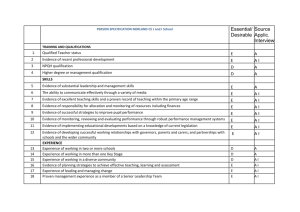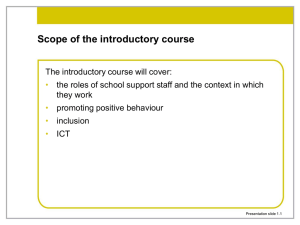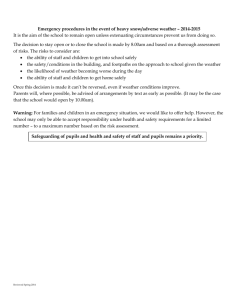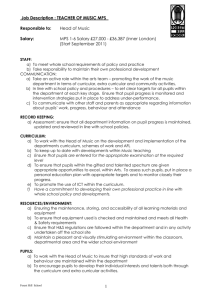Child Protection Information - Sir Thomas Boteler Church of England
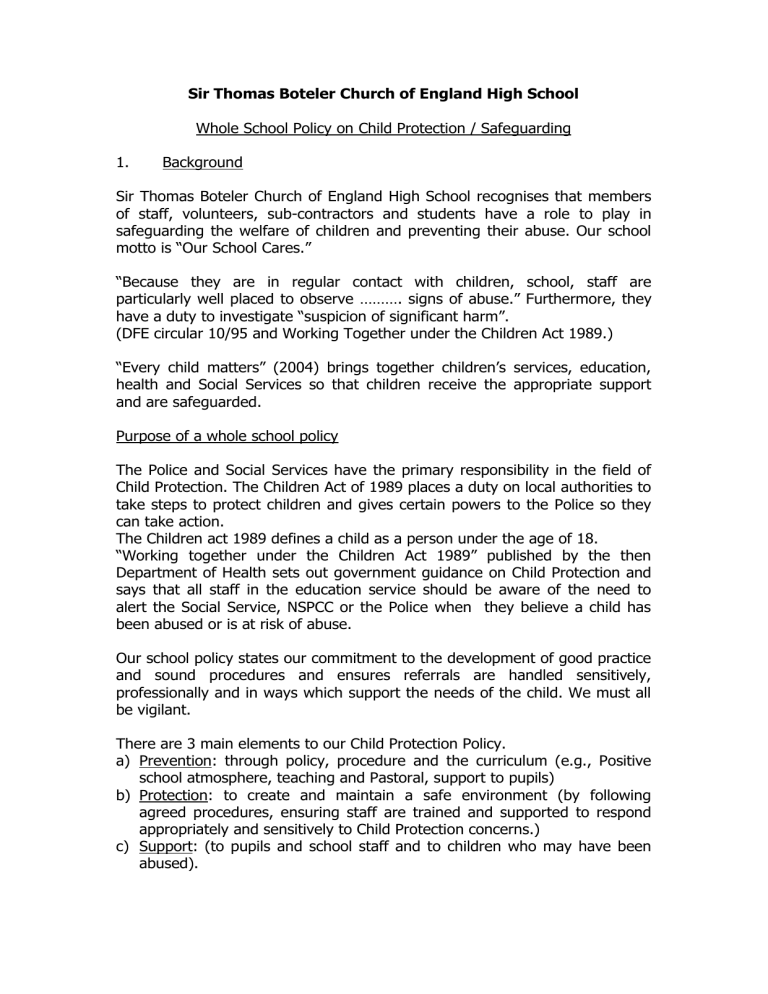
Sir Thomas Boteler Church of England High School
Whole School Policy on Child Protection / Safeguarding
1. Background
Sir Thomas Boteler Church of England High School recognises that members of staff, volunteers, sub-contractors and students have a role to play in safeguarding the welfare of children and preventing their abuse. Our school motto is “Our School Cares.”
“Because they are in regular contact with children, school, staff are particularly well placed to observe ………. signs of abuse.” Furthermore, they have a duty to investigate “suspicion of significant harm”.
(DFE circular 10/95 and Working Together under the Children Act 1989.)
“Every child matters” (2004) brings together children’s services, education, health and Social Services so that children receive the appropriate support and are safeguarded.
Purpose of a whole school policy
The Police and Social Services have the primary responsibility in the field of
Child Protection. The Children Act of 1989 places a duty on local authorities to take steps to protect children and gives certain powers to the Police so they can take action.
The Children act 1989 defines a child as a person under the age of 18.
“Working together under the Children Act 1989” published by the then
Department of Health sets out government guidance on Child Protection and says that all staff in the education service should be aware of the need to alert the Social Service, NSPCC or the Police when they believe a child has been abused or is at risk of abuse.
Our school policy states our commitment to the development of good practice and sound procedures and ensures referrals are handled sensitively, professionally and in ways which support the needs of the child. We must all be vigilant.
There are 3 main elements to our Child Protection Policy. a) Prevention: through policy, procedure and the curriculum (e.g., Positive school atmosphere, teaching and Pastoral, support to pupils) b) Protection: to create and maintain a safe environment (by following agreed procedures, ensuring staff are trained and supported to respond appropriately and sensitively to Child Protection concerns.) c) Support: (to pupils and school staff and to children who may have been abused).
PREVENTION
1. School Commitment
We recognise that for children, high self-esteem, confidence, supportive friends and clear lines of communication with a trusted adult helps prevention.
Our school will therefore: a) Establish and maintain an ethos where children feel secure and are encouraged to talk, and are listened to; b) Ensure that children know that there are adults in the school who they can approach if they are worried or are in difficulty; c) Include in the curriculum activities and opportunities for PHSE which equip children with the skills they need to stay safe from abuse. Some of the themes which will be included with this in mind are:
Emotions
Relationships
Rights and Responsibilities
Bullying
Peer Pressure
Assertiveness
Parenting Skills
Families
E safety d) Include in the curriculum material, which will help children develop realistic attitudes to the responsibilities of adult life, particularly with regard to child care and parenting skills. e) Ensure that wherever possible every effort will be made to establish effective working relationships with parents and colleagues from other agencies.
2. Procedures
2.1 We will follow the procedures set out in the Warrington Area Child
Protection Manual of Procedures.
Staff in school will require regular updates of policy and practice through INSET/meetings.
Training will be provided for all new staff.
The procedure outline will be posted on the staffroom noticeboard, in Student Services and in other relevant places to ensure staff have sight of it.
Parents are informed about Child Protection through the school prospectus.
(Child Protection : Parents should be aware that the school will take any reasonable action to ensure the safety of its pupils. In cases where the school has reason to be concerned that a child may be subject to ill treatment, neglect, or other forms of abuse, staff have no alternative but to follow Child Protection procedures and inform Targeted Services of their concern.)
PROTECTION
3. Framework
School do not operate in isolation. Child Protection is the responsibility of all adults and especially those working with children. The development of appropriate procedures and the monitoring of good practice are the responsibilities of the Area Child Protection Committee
(ACPC).
Their function is to co-ordinate borough-wide approaches to Child
Protection. This is to become a Local Safeguarding Children Board –
Every Child Matters.
The Child Protection register is a list of children who are monitored, supported by Social Services as they are at risk. It is held by Targeted
Services.
There are regular meetings, case conferences of children who are on the register and progress is reviewed with the aim to remove children from the register once safety is assumed and Safeguarding is no longer required. The meetings are the responsibility of Social Services and
Health and Education are core departments represented.
4. Roles and Responsibilities
4.1
All adults working with or on behalf of children have a responsibility to protect children. There are, however key people within schools and the
LA who have specific responsibilities under Child Protection procedures.
4.2
The Designated Senior Staff (DSP) in school are Paul McAleese and Bev Scott-Herron (in accordance with circular 10/95). All
staff have been made aware of these roles.
The responsibilities are:
To ensure that effective communication and liaison with Social Services and other agencies takes place as appropriate in the event of staff having Child Protection concerns about a child.
To ensure that staff (including the Head Teacher, teachers and non teaching staff) have an understanding of child abuse and its main indicators, and are aware of the schools and their own Child Protection responsibilities within Area Child Protection Committee procedures.
To support and advise staff in their Child Protection issues.
To liaise with the Head of PHSE with respect to Child Protection issues.
To maintain their own knowledge and awareness of the issues, policy and practice of Child Protection through regular attendance at appropriate training courses etc.
In the event of a member of staff (whether teaching or nonteaching) having a Child Protection concern about a pupil, she/he will immediately inform the DSP (PMcA and/or BS) and record accurately the event/s giving rise to the concern. If neither is available then Bernadette Keane, School Counsellor
or John Sharples, Headteacher will assume responsibility. DSP completes a referral form and faxes this to the appropriate services team/ a copy is held in school. No further action may be necessary.
However, a note of the concern is made and held in the DSP’s records and Social Services are notified.
4.3
The Head Teacher has a responsibility to appoint a Designated Senior
Person, or to act in this role him/herself. She/He must be informed of all referrals to Social Services.
4.4
The named Governor responsible for Child Protection is Mrs Carol
Ratcliffe. Her role is to ensure policy/procedures are in place. She will not have information about specific cases or children but will inform the Governing body of school practice.
4.5
The LA Child Protection Co-ordinator is currently Emma Coupe. In cases where the best option is unclear school staff are encouraged to consult with Social Services or the LA LAD officer.
The LA LAD officer (Emma Coupe) requires a copy of the referral form within 48 hours.
She/he needs to be involved in certain cases i.e:
Pupil or pupil abuse of a sexual nature.
Allegations made as a result of ‘restraint’.
Allegations against school staff.
The role of the LA LAD officer is to support schools in policy
5. Professional Confidentiality
5.1
Confidentiality is an issue which needs to be discussed and fully understood by all those working with children, particularly in the context of Child Protection. The only purpose of confidentiality in this respect is to the benefit of the child.
A member of staff must never guarantee confidentiality to a child because this is unprofessional; they are not in the best position to deal with issues of a Child Protection basis and must pass this on.
They should explain to a child that they may have to report what is shared but that they are willing to listen and provide support.
The only other person the teacher ought to share this information with is the DSP or the Head Teacher. (see overview sheet on procedures).
The DSP will then decide whom to contact and whether advice or a referral is the route to follow.
SUPPORT
6. Training and Support
6.1
Our school will ensure that the Head Teacher, the DSP and the nominated Governor for Child Protection attend training relevant to their role.
7. Records and Monitoring
7.1
Well kept records are essential to good Child Protection practice. Our school is clear about the need to record any concerns held about a child or children within our school, the status of these records and when these records should be passed over to other agencies.
A note (or email) is usually completed by the member of staff involved and passed to the Child Protection Co-ordinator.
Further records are then kept in a filing cabinet drawer in the Progress
Office, once these become a Child Protection Concern. Only BS and
PMcA have access via a key.
PMcA, BS and the Head of School/House/Personal Tutor monitor Social
Services involvement through the range of opportunities.
Implementation of the policy will be monitored by liaison between the
Link Governor and the DSP.
1.
Multi-agency review days, once per half term will involve Social
Services whenever possible.
2.
Pupils on the ‘at risk register’ will be involved in regular case conferences and usually the Personal Tutor, Assistant Head of
House or Head of House attends, minutes are held in the C.P. file.
3.
PMcA speaks to Social Workers involved in cases regularly as does
BS.
4.
PMcA/Heads of House/School as deemed appropriate and/or applicable, keep staff informed on a need to know basis or will make appropriate statements of concern to alert staff through briefing/pastoral briefing and by email.
5.
Parents have access to the pupil file and will also receive case conference minutes. However, this is not the case regarding accusations of physical or sexual abuse.
6. Child Protection files are kept, as other data, for a fixed number of years after the child leaves the school or they are passed on to the new school / college.
8. Attendance at Child Protection Conferences
A Child Protection conference is a meeting of all interested parties,
Parents, Education, Health and Police and is managed by Social
Services. The meeting reviews progress, plans intervention where required and ensures safeguarding of the child / children.
Staff must avoid asking children unnecessary questions as the
C.P. team/Police will interview them.
The conference is called and chaired by Social Services.
Our school recommends that the Personal Tutor attends the case conferences generally although Heads of House/Assistant Heads of
House and the DSP will often attend particularly in difficult/ challenging cases.
The Designated Person will offer support and advice and guidance to all staff attending conferences from school and meet to share outcomes where appropriate.
Staff attending, must complete the standardised referral form to share at the conference and must be prepared to vote on outcomes.
Maintaining a working relationship with parents, before, during and after referral is made is absolutely crucial. Staff will be supported by the DSP and the Head Teacher. It is important that staff are sensitive to the feelings of family members which may be extreme in these situations.
9. Supporting Pupils at Risk
9.1 Our school recognises that children who are abused or who witness violence may find it difficult to develop a sense of self worth and to view the world in a positive way. This school may be the only stable, secure and predictable element in the lives of children at risk. Whilst at school, their behaviour may still be challenging and defiant and there may even be moves to consider suspension or exclusion from school.
It is also recognised that some children who have experienced abuse may in turn abuse others. This requires a considered, sensitive approach in order that the child can receive appropriate help and support and the safety of other pupils is ensured.
The School Counsellor is trained and experienced in providing support to abused children and their families. She is also available to support staff.
9.2 This section will endeavour to support pupils through: a) The curriculum to encourage self esteem and self motivation. b) The school ethos which promotes a positive, supportive and secure environment and which gives all pupils and adults a sense of being respected and valued. c) The implementation of school behaviour management policies. d) A consistent approach, which recognises and separates the cause of behaviour from that which the child displays. This is vital to ensure all children are supported within the school setting. e) Regular liaison with other professionals and agencies who support the pupils and their families. f) A commitment to develop productive, supportive relationships with parents, whatever it is in the child’s interests to do. g) The development and support of a responsive and knowledgeable staff group, trained to respond appropriately in Child Protection situations.
9.3 This policy should be considered alongside other related policies in school. These are:
Staff conduct/management of allegations against staff.
Curriculum
Recruitment and Selection
Health and Safety
Behaviour Management
Restraint (use of)
Attendance
Anti-bullying
Acceptable use policy (Internet)
Sex Education Policy
Also consult:
1) Child Protection Procedure / Code of Conduct / Disciplinary Process
– Suspension (10.01)
2) Assessment of children in need (09.03 / Warrington Borough
Council, Social Services)
3) School procedures on Child Protection.
10 Safe School, Safe Staff
10.1
Children have a right to be safe. Staff need to be supported. Our school aims to ensure that safeguarding of children is of paramount importance. To this end we aim to keep current staff informed of policy/procedures and civil liberties as well as recruit ‘safe staff’ to school.
10.2
In our recruitment/selection procedures, Child Protection is always a question in interview so as to ascertain candidates’ knowledge/views as well as emphasise the key contribution school make in maintaining children’s welfare.
10.3
In order to avoid allegations being made against teachers/staff in school and in order to protect teachers/staff and children’s safety, our policy provides guidance and reference to other policies/procedures.
Avoid all physical contact with a child. Even a friendly gesture such as a pat on the back can be misinterpreted. If he/she wishes to leave the classroom due to a dispute it is wise to let him/her go and report the event rather than try to stop the child. Never bar the way. In cases of the need for restraint – see the restraint policy.
When mentoring/tutoring or counselling a pupil in a one to one situation, use a room with windows (a classroom with high visibility) or leave a door open. Maintain a reasonable distance from the pupil. Make sure colleagues are aware of the meeting.
Do not meet a pupil outside of school without telling a manager and taking a colleague
Always report non-work correspondence from pupils whether it be texts, e-mails or inappropriate contact
Keep hold of correspondence and note down dates of inappropriate verbal contact.
The Counsellor is available for referrals of a personal matter.
It is essential that all members of staff read the LA’s Child
Protection Procedure Code of Conduct (attached). This gives clear guidance in assisting all members of staff in maintaining entirely proper and professional relationships with pupils.
This Child Protection Policy is to be reviewed within the policy review cycle
(2–3 years) by a cross section of staff/parents/governors.
LN/WW/POLICYSTATEMENTS/CHILDPROTECTION
Amended 30 th
Updated BC June 2007
Amended 11 th
April 2004
March 2011
Updated PMcA March 2011



